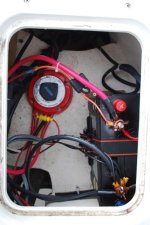ferret30
New member
- Joined
- Mar 22, 2011
- Messages
- 569
- Reaction score
- 0
- C Dory Year
- 2006
- C Dory Model
- 22 Cruiser
- Vessel Name
- Lily Pad
Hey guys, when I was doing the big clean/detail job last month I took the batteries out of the compartments in the cockpit. One was a cranking battery and the other a house battery(?), one on each side. The starboard side has the battery selector switch, and is open to below with many of the lines to the engine running through it. The battery is tied down with a strap and prevented from moving laterally by some strips on the floor of the compartment.
The port side is an enclosed compartment (except for the drain at the bottom). There is nothing holding the battery in place besides friction. When we got the boat there were some empty sealed detergent bottles in the compartment (floats?) that probably helped keep the battery from moving.
If I want to avoid drilling holes/epoxying for now, how could I secure the battery?
Is the battery selector picking a battery for starting? Or does it select which battery or batteries to charge off the motor?
The port side is an enclosed compartment (except for the drain at the bottom). There is nothing holding the battery in place besides friction. When we got the boat there were some empty sealed detergent bottles in the compartment (floats?) that probably helped keep the battery from moving.
If I want to avoid drilling holes/epoxying for now, how could I secure the battery?
Is the battery selector picking a battery for starting? Or does it select which battery or batteries to charge off the motor?


